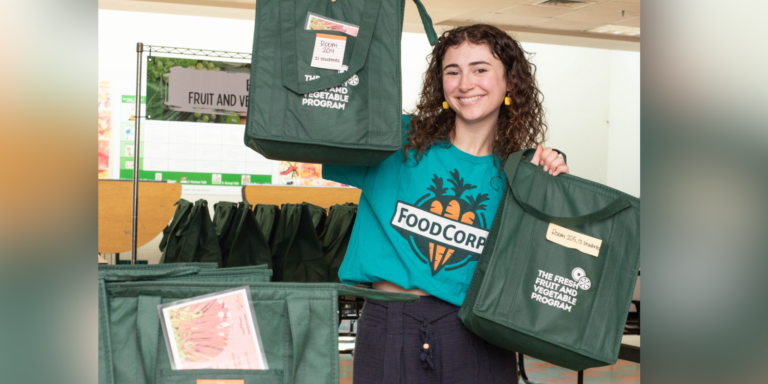Growing Our Impact with a School Garden: How We Became One of America’s Healthiest Schools
This is a guest post from our friends at Alliance for a Healthier Generation.
NEW! Explore our 2024 Voter Guide and make a plan to vote. Download the FoodCorps Voter Guide.
This is a guest post from our friends at Alliance for a Healthier Generation.

This is a guest post from our friends at Alliance for a Healthier Generation.
By Deborah Branch, Science Teacher, Buck Lodge Middle School, Prince George’s County Public Schools, MD
By the time a fruit or vegetable makes it to your plate, an entire process has taken place—what was once a small seed has grown from its hollow hole in the ground into a colorful, healthy form of nourishment. Watching this process, from seed to plate, is one of the great joys of gardening. As an educator, being able to extend this opportunity to my students is one of the great joys of teaching. From bright tomatoes to juicy strawberries, my students take such pride in growing crops and getting to taste new, healthy foods!
At Buck Lodge Middle School, we take the “whole child” approach and believe that every child should be healthy, safe, engaged, supported and challenged. Through this approach and our work with the Alliance for a Healthier Generation’s Healthy Schools Program, we ensure that Buck Lodge supports good health, and that students learn healthy eating habits that will last a lifetime. We accomplish this through many means including implementing a robust district wellness policy, garnering help from the community, and achieving support from our school administration—and now, we’ve been nationally recognized for our efforts as one of America’s Healthiest Schools!
Our school has roughly 1,200 students, over 90 percent of whom are eligible for free or reduced-priced meals, so it is critical that the food that we provide is nutritious and appealing. We know that healthy students are better learners, so it is important to us that we fuel their bodies to best succeed in the classroom. In addition, we want our students to learn how to make healthy food choices, grow their own food and be stewards of their environment. Our urban garden, which was started in 2011, has allowed us to teach our students about these things and so much more.
There are typically at least 50 students working in the garden throughout the year. In addition to gaining confidence in feeding themselves, students are able to understand the process of going from seed to harvest to table, all with no pesticides or herbicides. We also utilize the garden extensively during our summer STEM camps, enrichment classes and afterschool clubs, proving that integrating STEM and wellness concepts with garden activities is easy!
Most of all, however, students get excited about eating the “fruits” of their labor, as food from the garden goes directly to students and staff. Students may eat the food in the cafeteria, as part of a taste testing lesson, and sometimes take foods home to their families. The remaining harvest is made available to school staff, including teachers and custodial staff. Over the past two years, we have grown cucumbers, cherry tomatoes, beefsteak tomatoes, green peppers, mint, beets, strawberries, cilantro, carrots, cantaloupe and watermelon!
Maintaining a school garden is just one of the many ways we’re prioritizing and promoting health in our school. Because of our work, in part, with the Healthy Schools Program, we’ve developed a total culture of wellness at our school. Our students look forward to staying active each day, and revel in opportunities to participate in their own health and wellness—and we see the positive impact this has on academic performance, attendance and behavior. Our staff have also embraced our healthy school culture, with many of them making personal lifestyle changes to improve their overall health and well-being.
With the support of the Healthy Schools Program, you, too, can “grow” your impact and become one of America’s Healthiest Schools. Enroll the school in the Healthy Schools Program to access free guidance, tools and trainings today!
The Alliance for a Healthier Generation and FoodCorps believe that school gardens, farm to school activities and exposure to nutrition education will ensure that students form healthy eating habits from a young age and understand where their food comes from. FoodCorps supports schools in growing school gardens, making linkages between the garden and the cafeteria, and improving school health and wellness policies. FoodCorps currently works in 18 states and places AmeriCorps Service Members directly in schools.

A Day in the Life: Eva Gertz, School Nutrition Member

What is the National School Lunch Program?

Recap: Our Summer Movement Building Series